|
|
|
|
| What can I do to improve students' reflective writing using electronic portfolios? |
|
|
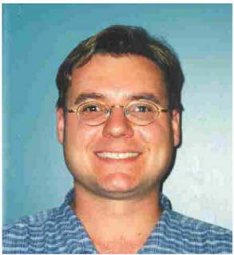 |
Biography
George Neeb currently teaches Grade 6 at North Ward Public School in Paris, Ontario. This is his third year at North Ward, but his 12th year of teaching.
George has a Bachelor of Arts degree in Psychology from McMaster University and completed his Bachelor of Education at Western University, after which he earned his Masters of Arts in Teaching at McMaster in 1997.
This is his second Action Research project. His first investigated improving students' communication in math as part of an Educational Quality and Accountability Office (EQAO) study. His findings were published in Passion In Professional Practice: Action Research in Grand Erie (2001) and on the OAR website www.nipissingu.ca/oar.
George and his wife, Tracie, have three young sons, aged 1, 3 and 5 years.
|
|
|
Abstract
I developed student electronic portfolios with Grade 5 and 6 students that combined computer technology with traditional portfolios. Students collected examples of their work, digital photos and reflective evaluations to highlight their own growth and development. Working with colleague, Sandie Fulford, various techniques and approaches were developed to have students complete personal portfolios using Corel Presentations for each term.
My research question was: "What can I do to improve students' reflective writing using electronic portfolios"
Introduction
"The best thing about doing electronic portfolios is it's fun and you learn a little about yourself." Larissa Luke, Grade 6
It was a cold blustery day in December 2000 when I made my way from Brantford to Toronto to help present findings from an Action Research project on improving EQAO testing results at the Ontario Educational Research Council Conference. By the time I made it by car, train, subway and foot in a heavy snowfall to the OISE building, I didn't have much time before my own presentation to listen to others' research. By chance, I wandered into a presentation by Micheline Joseph from the York District School board on electronic porfolios. She had her students highlighting their own growth and development using photographs, examples of work and reflective writing throughout the school year, all neatly presented in a slideshow format with special effects and saved on personal CD's. I was immediately mesmerized by her students' technological abilities and concise reflective writing. I thought how interesting it would be to try something like this with my own class. As other priorities took precedence, I didn't give much more thought to electronic portfolios until later that year.
In June of 2001, I was approached by Program Co-ordinators James Ellsworth and Diane Morganto participate in another Action Research project. I suggested that I would like to try electronic portfolios with my class the following September. James offered me the funds to buy a CD burner and a set of CDs for my class. The rest would be up to me.
In September, Sandie Fulford, a Grade 5 teacher at North Ward heard about this project I was going to be trying and asked if she could become involved. She would create electronic portfolios with her class and also play the role of critical friend to me.
Procedure
Before we could begin using electronic portfolios, Sandie and I had to make many decisions on what our version of the electronic portfolio would look like. We decided to use Corel Presentations, as I was fluent with the program and thought it would be a good starting point. We decided that our portfolio focus would be on improving students' reflective writing about topics studied, best work and their own performance. One of our school's literacy initiatives was a project with Consultant Jan McClelland to include graphic organizers in students' written work. One organizer that we believed would help organzie students' reflective writing was the use of the PMI from deBono (1987). PMI stands for "Plus, Minus and Interesting". Students would tell a plus, or a positive about a unit of study, or their own performance, a minus, and a statement of interest.
When finished, the portfolio would run like a slide-show with plenty of photographs, graphics and special effects. Also, each student would be given their own "CD" on which to save their portfolios so they could take them home to share and keep for years to come.
Throughout September and October, I made sure to take plenty of photographs of happenings in the classroom using the school's digital camera. Learning to use the camera was a bit frustrating. I wrote in my journal on October 10, 2001, "I have tried to use the digital camera - but we cannot find the battery charger. I used a regular camera instead and took photos of paper sculptures for their portfolios. I'll scan these. My concern is the technological aspect of this project. The scanner is temperamental and the digital camera is missing its battery charger. "
|
 |
|
Erica discusses her electricity project on this slide. She enjoyed the homework portion of the unit.
|
|
| By mid-October, I had students on the computers, learning Corel Presentations, creating their own portfolios. |
 |
|
Jamie chooses a background colour to enhance her portfolio.
|
|
To help students learn the program I trained a few students during class time then had them teach others in the class. I wrote on October 12, "I have taught two students, David and Ray, how to use the digital camera. They were very impressed. Teaching them how to use the program and all its features is tiring, yet enjoyable and rewarding. I wish I had more time to spend with each student to appreciate his or her work...I have booked a computer time for the lab everyday next week. The class is loving this project. I should have the students start dating all entries."
I gave the students a handout to help them begin which explained which topics should be covered in their portfolio (see Appendix 1). I would give suggestions about topics, but also reminders on using PMIs or similar organizers to reflect on their own learning.
|
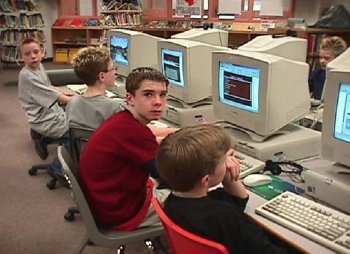 |
|
Access to a computer lab allows all students to work at the same time on their portfolios. this fosters a cooperative learning environment.
|
|
| Sandie and I talked a lot about how to evaluate our portfolios. We knew that many skills were being developed during the process, especially Learning Skills. For example, in developing their portfolios students are working independently, showing initiative, using information, cooperating with others, problem solving and goal-setting to improve work. |
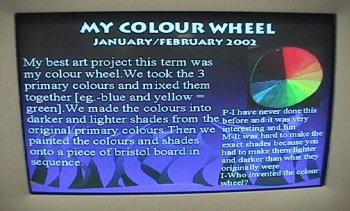 |
|
Erica uses a PMI (Plus, Minus, Interesting) to discuss her "best" art project of the term.
|
|
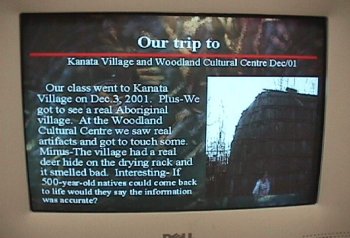 |
|
Ray highlights our class trip to a museum with a PMI. Notice his thoughtful "Interesting"
|
|
| When students are sharing their portfolios with peers, teachers and parents, they are developing oral communication skills, such as communicating a main idea and describing a sequence of events, using vocabulary learned, and expressing and responding to ideas and opinions. Students are also developing keyboarding skills, reflective writing, technological skills (Corel Presentations program, burning CDs, digital camera usage, scanning photographs), communication skills (self-evaluating program, goal setting and student-led conferencing). Students were very aware of their own improvement in technological skills by doing electronic portfolios: |
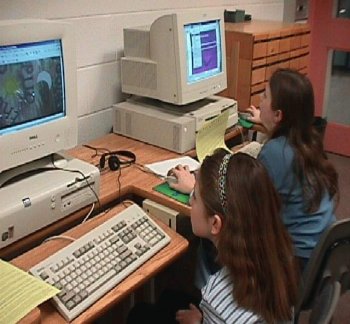 |
|
Heather and Breanne help each other add photographs and special effects to their portfolios.
|
|
"Portfolios have helped me to type better because you have to write about a lot of things that you did." (Emily Lewis)
"The best thing about doing electronic portfolios is they help me do better on my computer skills." (Jacob Cerson)
Sandie and I were aware of the many skills being taught, but we were unsure of which skills to evaluate and how to go about evaluating them. I wrote in my journal on Nov. 1, "I have been thinking a lot about how to evaluate these portfolios. Students can't include traditional samples in them, so samples can't speak for themselves, meaning a student can't include a great story that can be looked at and read as in a traditional portfolio. For one, our scanner doesn't work and second, the story wouldn't fit [into a Corel Presentations page]. Thus, my evaluation will need to focus on student reflections. After last day's meeting with Diane and Sandie, I really like the idea of a PMI reflection. Students are familiar with these because of our school's work with Jan McClelland.... I think for this evaluation I'll look at the way EQAO assesses English compositions [using] Reasoning...Communication... Organization.... [and] Conventions. I'll explore this idea with Sandie." After much thought and discussion, we decided to revise this evaluation approach slightly. I wrote on November 9, "I have been doing much reading on portfolios....I'm changing my evaluation criteria. I can't make EQAO's criteria fit. I'm going simpler - Completion, Depth of Reflections, Creativity and Conventions."
I shared a draft copy of the evaluation and discussed it with the class (see Appendix 2). I asked students for feedback on the evaluation and for any other ideas to include. As students completed their first portfolios, I conferenced individually with each student on the technological aspects of his or her portfolio and asked questions such as: "Did you animate all photos? Did you experiment with slide transitions? Did you leave enough time to read the page before a new slide appeared?" I would also conference to encourage students to think about their reflections and goal-setting.
Findings and Conclusions
To state that students enjoyed the process is an understatement! As with all computer projects, students were highly motivated to use technology. I gave my students a more formalized opportunity to express in writing their personal views about the process of creating electronic portfolios. Each student had something positive to say. Here are a few sample student responses:
"I think the best thing about doing electronic portfolios is getting your say on the units you do in school." (Ray Balberman)
"The best thing about doing electronic portfolios is in the future I can look at my portfolio and see what I did at school and show my kids (if I have any)." (Anonymous)
"My favourite part is actually getting to notice all the things I have worked so hard to complete this term because when I work so hard to finish and do a good job, I always forget about it and start something else and never look back at it again to appreciate it." (Jacob Burleigh)
Students were also insightful about how portfolios helped in their own learning:
"Portfolios have helped me to highlight the term so I [will] remember it in years to come." (Ray Balberman)
"Portfolios have helped me to write down all my thoughts and add more detail." (Anonymous)
"Portfolios have helped me to learn about what I have done in all the subjects and helped me to understand..." (Jacob Burleigh)
"Portfolios have helped me to write more descriptive sentences because I need to start using them in school more often." (Anonymous)
|
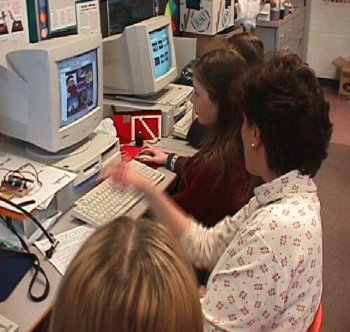 |
|
Teacher consultant Lori Barkans discusses student portfolios.
|
|
| Besides a method to assess student learning, these portfolios have also been used as a method of communication with parents. The Parent-Teacher conference held after Term One report cards was led by students with their portfolios being used as a starting point. When parents arrived for their interview, we all gathered around the computer and I had students review the last page of their portfolio which included their reflections about their own strengths, weaknesses and next steps. Then they played their portfolio, which showed parents what they had accomplished in this term. With the inclusion of many photos and special effects, all our hard work was showcased in an informative, creative media presentation. |
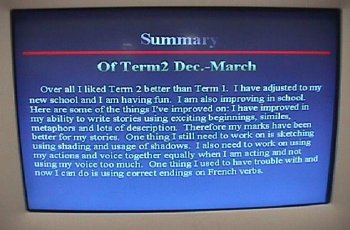 |
|
Ray discusses his strengths, weaknesses, and next steps. Summary slides were used as a starting point for student-led Parent-Teacher conferences.
|
|
Some students had even figured out how to include music to enhance the presentation. The response from parents was very positive. I gave each parent an opportunity to express in writing their views about the process (see Appendix 3). Here are a few sample statements:
"A feature of this portfolio that I particularly like is that it makes Ray reflect over the whole term...Thanks for teaching this to the class." (Loraine Balberman)
"I think it is a great idea!" (Joanne Motheral)
These parent comments could also be included in the actual portfolios. I wrote about this on November 16, "I met with my Principal today [Jane Foerter]. She too is excited about this project. We discussed the reflective process. She would like to see a parent slide and feedback. I had drafted a letter to go home with the CDs. We could scan this or students could retype it into a final slide."
I also had the pleasure of sharing, with my students, their portfolios with our Director of Education, Mr. Peter Moffatt during his visit to our school. He also included us in his Director's Report to school administrators. He wrote, "Goose Honkings.... Alignment and Accountability: To George Neeb and his Grade 6 students at North Ward for the creation of electronic student profiles on CD-ROM. Each student will be able to maintain a permanent record of progress on the single CD."
Mr. Moffatt also invited us to share our portfolios at a School Board meeting as part of 'his Directors report. We brought a student, Ray Balberman, to present his portfolio and share about the process, his own learning, and answer questions. Our Superintendent, Mr. John Bryant attended the presentation and wrote the following note to me: "Thanks for an outstanding presentation on Monday evening. Your students are fortunate to have you as their teacher. You are an asset to your school and the Grand Erie District School Board."
As a follow up to this presentation, The Brantford Expositor contacted us to do an interview for afeature story about the portfolio process. The article ran on Thursday, March 7, 2002 titled, "Students use computers to show off school work. Some North Ward pupils create electronic portfolios." (see a copy of the article in Appendix 4).
For Term 2, the process continued on similar to Term One, except I wanted to work on further developing students' reflective writing (see Appendix 5). I wrote on January 11, "I want to work on making their reflections have more depth. I will try using statement, example, elaborate..." One suggestion from my meetings with my Action Research colleagues was to have students orally discuss their reflections first, then write them (e.g. Think, Pair, Share).
I also took into account feedback from parent and students about what else to include. Parents wanted problem solving in math, gym, drama and dance. Some of these were included in Term One and Two expectations, but the option was always available to include a page of your choice. In Term Three, the options of what to discuss were much more open-ended for students (see Appendix 6).
Next Steps
"I would like to do portfolios again in Grade 7 too." (Anonymous)
As Sandie and I began to feel comfortable with the electronic portfolio process, the momentum to expand the project started to build within our own school. The North Ward staff has expressed much interest in making these portfolios a school-wide project. We believe that electronic portfolios are adaptable to varying grades and easily able to be personalized by different teachers. In this project, approximately 60 students were involved. Our plan is to include all Grade 5 and 6 next year, plus three Grade 7 classes (approximately 210 students). The year after, our intent is to have all North Ward students from Grade 1 - 8 involved (approximately 500 students). Including every student would mean that students in each grade would be creating a portfolio and saving them on their own personal CDs, which would be filled by the end of Grade 8. Upon graduation, students will have a memorable record of their years at North Ward and an impressive record of their own learning.
Sandie and I planned and implemented an after school PD session for our staff on using Corel Presentations. Sandie taught them how to use the digital camera, and I had staff creating their own slide show.
Our Computer Committee has already approved funds being used to begin in-servicing teachers on the technological aspects of electronic portfolios. We have decided to begin using the program Hyperstudio, which has more useful functions for the portfolios than Corel Presentations. Hyperstudio has a free download that can be copied onto student CDs so they can easily run their portfolios at home without needing Hyperstudio installed. Other advantages of Hyperstudio are the capability to include website links and scrolling textboxes. A Hyperstudio workshop is planned for April for the entire staff and a follow up session in May for those teachers beginning portfolios in the fall.
In order to further facilitate electronic portfolios being incorporated into daily classroom practices, my Principal and I submitted a proposal to our board's "Technological Innovation Pilot Project" grant with the hopes of securing funds to purchase more technological equipment for our school (e.g. digital cameras, CD burner, CD's, etc.) . Now, as the year comes to a close and I sit in the Spring warmth, I think back to that cold, grey December day that I first heard about electronic portfolios and realize how much I have grown in my own learning from this process. I have learned of the importance of giving students a chance to reflect and appreciate their work. Before doing portfolios, I would finish a unit and then begin another, leaving little or no time for students to think about their own learning. Portfolios have helped me to focus on evaluating fewer assignments, but in a more meaningful way. I give students the opportunity to choose their best work, and from that I can evaluate. Having students state what they have learned is a powerful assessment tool. Who knows better about what people have learned than the people themselves? I am proud to have given my students an opportunity to have a voice and permission to critique. I have also gained much more confidence in using technology. I hadn't touched the digital camera or used a CD burner before this project, and now I'm taking digital photos and burning CDs daily, and teaching others to use these technologies. Lastly, Action Research has encouraged me to use a journal and keep track of my own reflections, so I too have a permanent record of my own learning.
In conclusion, I believe strongly in the effectiveness of electronic portfolios. They are an effective motivator for student self-improvement, as students are inspired to produce quality work to include in their portfolios. The computer is a natural motivator and allows much personal creativity. Parents enjoy viewing highlights of their children's work and like storing a CD (as opposed to a collection of paper work). I also believe that the possibility is real that electronic portfolios could become a permanent means of student assessment throughout Grand Erie, once teachers and students understand how useful this multi-faceted assessment and evaluation too can be.
|
|



